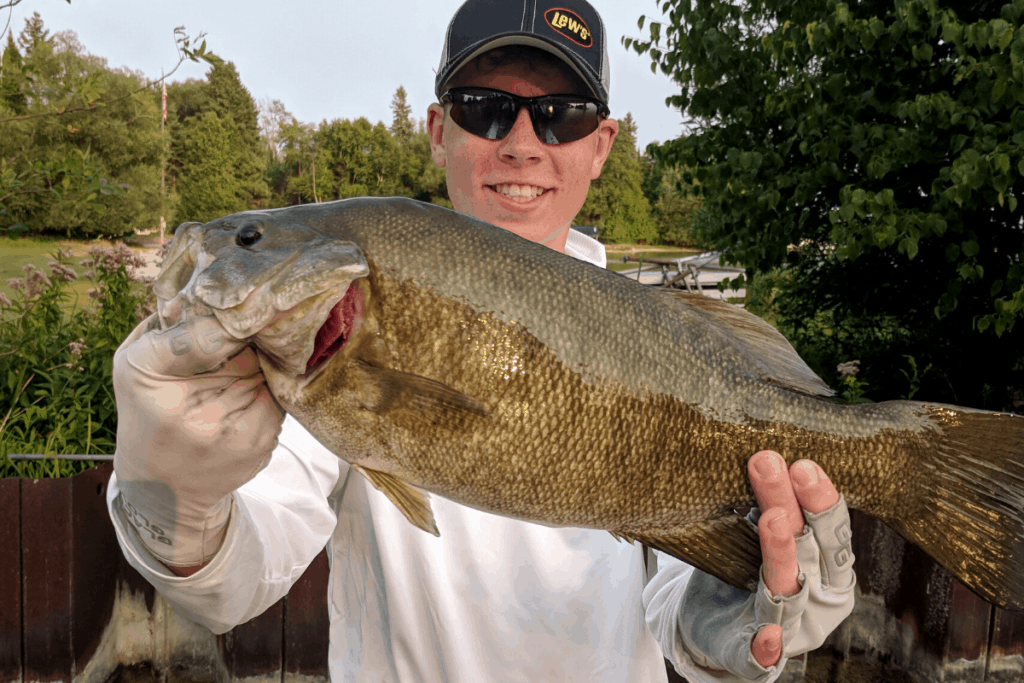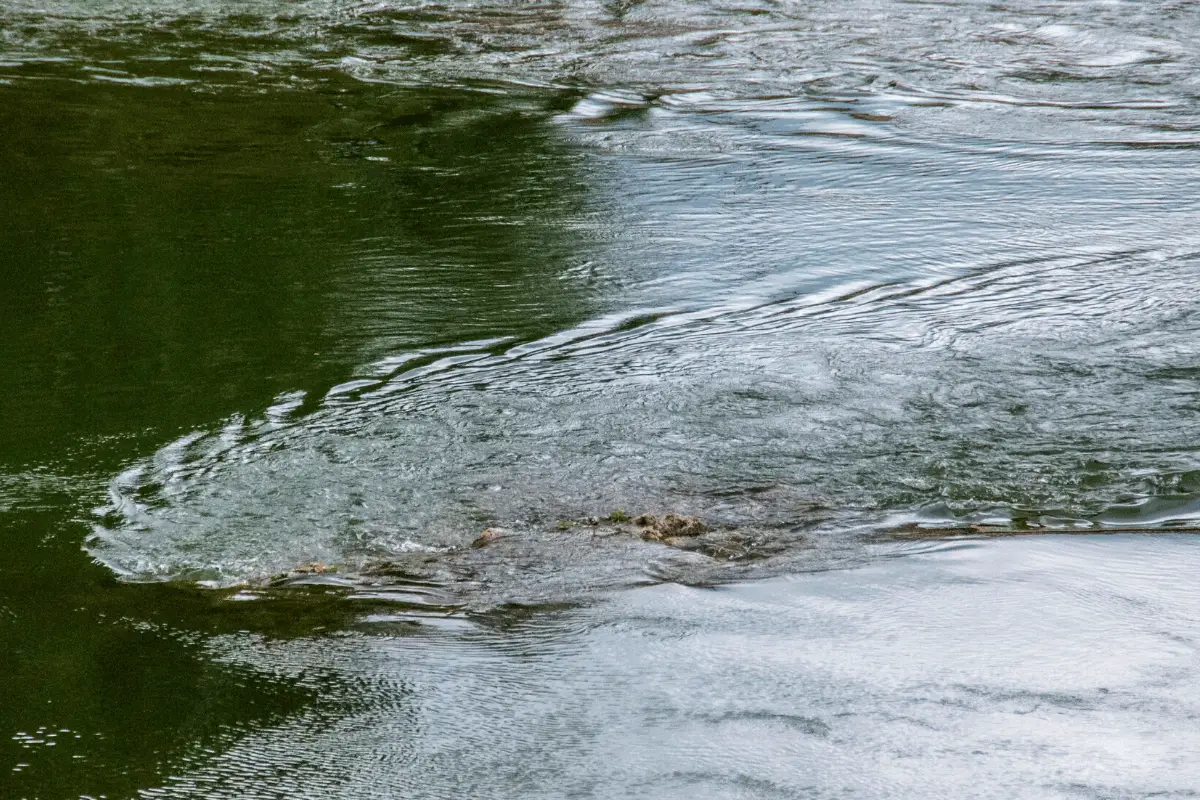Fish can be predictable. Current is one of those tools that anglers can use to help find and catch bass. There are three types of current that I love to talk about. These are helpful to increase your odds of being successful: natural current, wind-blown current, and man-made current.
Bass use current to make it easier for them to find food. In a natural river system, bass will face into the current most of the time. Use this to your advantage. Present your lures so they drift down with the current into areas where bass are likely to ambush the prey: behind rocks or trees, in eddy pools, or along deeper pockets.
Let’s break down the three types of current and how we can use them to our advantage.
Natural Current and Bass Fishing
I refer to natural current in terms of rivers and streams that have the “traditional” flow to them. Natural current systems position fish into very predictable areas that we, as anglers, can take advantage of.
Like humans, bass would prefer to eat with as little movement as possible. It is critical that they take in more calories than they burn. Their survival depends on this basic rule of nature.
Natural current systems make this easy for them. Prey fish and forage are pushed downstream. Bass tend to sit in ambush locations waiting for this forage to pass by for an easy meal.
When actively feeding, they will sit on the front side of a current break, like a rock or tree. As the current splits around the object, it forms an eddy pool. Our favorite predator can easily sit in this slack water and see what is coming downstream towards them.
When a bass is in more of a loafing, or resting mode, they will slip to the downstream side of the current break. While they may not be actively feeding at this time, they will still take advantage of an easy meal.
Wind Blown Current
Unlike natural current, this type of current is created on every body of water around the world. The only problem is, the wind doesn’t blow all of the time.
Most anglers tend to avoid the wind at all costs. It makes casting difficult, boat control can be daunting, and it drops the temperature. Toss those negative thoughts out of your head and get in the middle of it.
Like natural current, wind blown current positions bass into predictable locations. A strong wind will drive the microorganisms into the shoreline. Small baitfish will feed on these easy pickings. These little prey fish will draw in predators of all kinds.
The nice thing about fishing in the wind, is that bass that are on the windiest shoreline, are most likely aggressively feeding. Some of your strongest strikes will come on days when you can hardly stand to be out there.
Instead of retreating to the protection of a leeward shore, head to the windiest portion of your lake or pond. Cast lures that mimic the small baitfish that will be in the area and hang on – you are about to get some arm-ripping strikes.

Bass Fishing in Man-Made Current
The name of this current type is deceiving. It’s not man-made in the same sense as current generated from a damn. When I talk about man-made current I am referring to the wakes created by all kinds of recreational boats.
I used to avoid the weekends when waverunners, tubers, and water skiers were out en masse. Now I look forward to those days.
The wind will generally blow from one direction during a given outing. Boat wakes are not as predictable. These waves come from all directions and can slosh around to create quite the disturbance. The unpredictable patterns means the feeding frenzy will cover more parts of the lake. In other words, opposite shorelines may be just as good.
My wife and I were idling around the lake one Sunday afternoon admiring the view, but I had one eye on the churned up shore. A nice, frothy, mudline was forming with clearer water holding a few feet out. My instincts told me to hurry up the afternoon cruise and get a line in the water.
The first spot I pulled up to was getting hammered with boat wakes. The dock and pontoon attached to it were bobbing and creaking. The weeds around these targets were swaying from one side to another. In the next ten minutes we boated eight nice fish. They all hit with a vengeance.
Was it difficult to fish in the midst of such chaos? You bet. Did I have to be careful to stay out of the path of some giant ski boats? Yes I did. Did we experience a tremendous bite? Yep.
It takes some mental preparation to get in the middle of the boat traffic as opposed to finding a quiet, little, bay away from it. I had a hard time in the past convincing myself it was worth the effort, but it is. Take advantage of it and experience some of your best fishing all year.
Tips for Fishing the Current
Natural
When fishing rivers and streams, keep your lure and presentation as natural as possible. Let your bait drift and bounce down with the current. Change the size of your weight or line to maintain a natural drift. If your lure moves to quickly, or not fast enough, you are less likely to get bit.
Also, always look ahead at the types of current breaks and eddy pools coming up. Think about possible ambush points, throw past them, and let the lure drift to them. Be ready to get smashed.
Wind Blown
Before you head to the windiest shoreline on the water, take the time to adjust your reel’s braking system to accommodate for the situation. Usually, I just crank the brake up on my baitcaster one or two clicks and tighten my spool tension.
A quality reel with a good braking system will allow you to cast into the wind all day without trouble. Of course, practice helps.
Focus on lures that mimic the baitfish that are likely to be in the wind feeding on the microorganisms. If the waves are large enough and there are rocks, expect there to be crayfish getting dislodged and bouncing about as well.
Man-Made Current
This type of current is the trickiest to fish. Odds are, you will need to put your boat parallel with the shoreline and keep it as close to the bank as you can. Cast ahead as you work down the lake. This will do two things: you will stay clear of the recreational boat traffic and your lure will be in the target strike zone for a long time.
I love to use a swim jig on days when I am fishing man-made current, but my home lake has a lot of bluegills as the main forage base with thick weeds. A swim jig comes through the vegetation with ease and also is a perfect imitation of the prevalent panfish.
Final Thoughts
I always try to find one of these three types of current when I head to the boat ramp. A key to being a successful angler is to keep your lure in high percentage areas. Current eliminates a lot of empty water and keeps us in the zone longer.
On days when the wind is howling, you will also have the distinct advantage of finding no one else in the areas you want to fish. Most people will avoid the wind at all costs. Change your mindset and out fish them.
When the weekend rolls around and your favorite fishing hole is tore up with boat traffic, sit back and smile. You know that those bigguns are going to be in those tore up shorelines picking up an easy meal.
Good luck out there and up your odds of catching a true trophy by targeting these three types of current.

